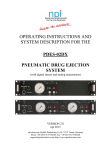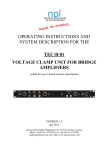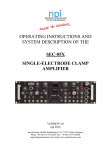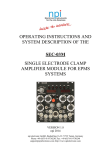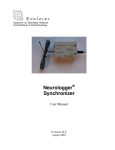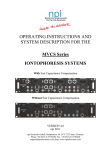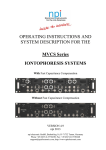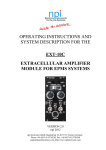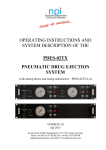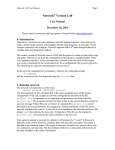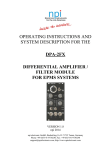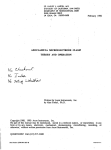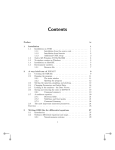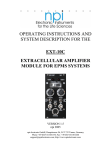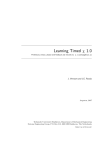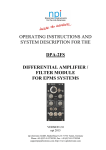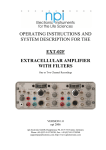Download SEC-10LX Manual - NPI Electronic Instruments
Transcript
OPERATING INSTRUCTIONS AND SYSTEM DESCRIPTION OF THE SEC-10LX SINGLE ELECTRODE SYSTEMS WITH APPENDICES: SEC Cell Model Tuning Capacity Compensation in SEC Amplifier Systems SEC-EXT Headstage for Extracellular Recordings with SEC Systems Calibration of SEC Amplifiers with x10 Headstage Calibration of SEC Amplifiers with x0.1 Low Voltage Headstage Synchronization of Two or More SEC Amplifier Systems SEC Systems with VCcCC mode SEC Systems with DHC mode SEC Systems with Linear Mode VERSION 3.5 npi 2010 npi electronic GmbH, Hauptstrasse 96, D-71732 Tamm, Germany Phone +49 (0)7141-9730230; Fax: +49 (0)7141-9730240 [email protected]; http://www.npielectronic.com 1. Safety Regulations VERY IMPORTANT: Instruments and components supplied by npi electronic are NOT intended for clinical use or medical purposes (e.g. for diagnosis or treatment of humans) or for any other life-supporting system. npi electronic disclaims any warranties for such purpose. Equipment supplied by npi electronic must be operated only by selected, trained and adequately instructed personnel. For details please consult the GENERAL TERMS OF DELIVERY AND CONDITIONS OF BUSINESS of npi electronic, D-71732 Tamm, Germany. 1) GENERAL: This system is designed for use in scientific laboratories and must be operated by trained staff only. General safety regulations for operating electrical devices should be followed. 2) AC MAINS CONNECTION: While working with the npi systems, always adhere to the appropriate safety measures for handling electronic devices. Before using any device, please read manuals and instructions carefully. The device is to be operated only at 115/230 Volt 60/50 Hz AC. Please check for appropriate line voltage before connecting any system to mains. Always use a three-wire line cord and a mains power-plug with a protection contact connected to ground (protective earth). Before opening the cabinet, unplug the instrument. Unplug the instrument when replacing the fuse or changing line voltage. Replace fuse only with an appropriate specified type. 3) STATIC ELECTRICITY: Electronic equipment is sensitive to static discharges. Some devices such as sensor inputs are equipped with very sensitive FET amplifiers, which can be damaged by electrostatic charge and must therefore be handled with care. Electrostatic discharge can be avoided by touching a grounded metal surface when changing or adjusting sensors. Always turn power off when adding or removing modules, connecting or disconnecting sensors, headstages or other components from the instrument or 19” cabinet. 4) TEMPERATURE DRIFT / WARM-UP TIME: All analog electronic systems are sensitive to temperature changes. Therefore, all electronic instruments containing analog circuits should be used only in a warmed-up condition (i.e. after internal temperature has reached steady-state values). In most cases a warm-up period of 20-30 minutes is sufficient. 5) HANDLING: Please protect the device from moisture, heat, radiation and corrosive chemicals. 300 8k 200 0.1 100 10k % 0.4 10 0.2 OFF OFF 300 MW 13k 100 VC COMPUTER CONTROL + 456 30 20 V/nA 1/4 50 40 60 ON 1/2 + THRESHOLD 456 DISABLED SEC-10LX npi RESET STEP SIZE nA + /10mV STEP GATE TTL VC COMMAND INPUT 32 - - 24 OFF OFF 3 7 0 CURRENT OUTPUT 25 ELECTRODE CLEAR ON 16 36 17 HEADSTAGE BIAS CURRENT 8 00 90 10 FREQUENCY 8 8 00 90 10 00 90 10 OFFSET CAP. COMP. DURATION x10mV 34 ON CURRENT CLAMP POTENTIAL OUTPUT 33 AMPLITUDE PULSE Imax OFF BUZZ 80 70 0 OFF /40mV 00 90 10 SWITCHING FREQUENCY SWITCHING FREQUENCY kHz 0 8 + 80 70 DUTY CYCLE 1/8 VOLTAGE CLAMP 30 10 MW/TURN 13k - STEP SIZE mV BRIDGE BALANCE 456 10 80 70 29 0.1 + MODE OF OPERATION 100 MW/TURN 5 REL ON 80 70 23 10k 50 20 20k 0 - 3 7 0 GROUND BR 0 GAIN OFF CC OFF 8 AUDIO 8k 200 00 90 10 ON 3k 5k 0.2 HOLDING CURRENT nA 1.8 2.0 ms 1k 1.3k 2k 700 500 HOLDING POTENTIAL mV 1.6 VC OUTPUT LIMITER 50 20 20k CURRENT OUTPUT OSCILLATION PENETRATION SENSITIVITY SHUT-OFF 1 2 0.5 CURRENT FILTER Hz CURRENT nA 80 70 90 100 20 10 ms OFF POTENTIAL/RESISTANCE mV 18 30 20 30 RISE TIME 1 0.8 1.2 1.4 0.6 POTENTIAL FILTER Hz 1k 1.3k 2k 700 3k 5k 500 11 30 20 INTEGRATOR TIME CONST. 5 VC ERROR 13 30 20 70 10 9 7 12 3 2 1 0 1 2 3 80 8 19 PI-CONTROLLER 60 50 40 6 30 20 POWER 20 5 50 40 60 15 4 50 40 60 14 3 50 40 60 2 50 40 60 1 21 STEP GATE TTL 37 26 1nA/V 0.1nA/V CURRENT STIMULUS INPUT 38 40 41 27 TTL REMOTE HEADSTAGE INPUT 42 43 28 22 CONTROLS AND CONNECTORS FRONT PANEL ELEMENTS 1 POWER POWER This switch turns on the power supply. The line fuse, line voltage selector and power cable connector are located on the rear panel. 2 VC ERROR VC ERROR This analog display shows the error in the VC (voltage clamp) mode (command minus recorded potential). The desired range of operation is around zero. 3 INTEGRATOR TIME CONSTANT INTEGRATOR TIME CONSTANT In the most left position the integrator is turned off i.e. the VC controller has only proportional characteristic. By turning the knob clockwise the integrator is set on i.e. the VC controller has a PI characteristic (proportional and integral), which reduces the error considerably (theoretically to zero). The time constant of the integrator is set with a ten-turn potentiometer 3 (clockwise: time constant is decreased, effect of integrator is increased). When using the integrator, step commands applied to the input can cause overshoots, which can be reduced with the RISE TIME control 24. 4 POTENTIAL FILTER POTENTIAL FILTER Low pass Bessel filter for the POTENTIAL OUTPUT (see also CURRENT FILTER 8). The setting of the filter is monitored at FREQUENCY MONITOR POTENTIAL at the rear panel. 5, 6 DISPLAYS DISPLAYS 5 POTENTIAL/RESISTANCE: display for the recorded potential in mV (B; C; V modes) or the electrode resistance in MW (R mode). 6 CURRENT nA: display for the membrane current in nA. 22 7 CURRENT OUTPUT SENSITIVITY CURRENT OUTPUT SENSITIVITY This switch sets the sensitivity of the current output (0.1-10 V/nA, seven position rotary switch). The setting of OUTPUT SENSITIVITY is monitored at CURRENT SENSITIVITY MONITOR at the rear panel. 8 CURRENT FILTER CURRENT FILTER (20Hz – 20 kHz, 16 position rotary switch) · 4-pole tunable Bessel filter (24dB/oct) with 16 corner frequencies, selected by a rotary switch. · The following 16 frequencies can be set: 20, 50, 100, 200, 300, 500, 700, 1k, 1.3k, 2k, 3k, 5k, 8k, 10k, 13k, 20k (Hz) The setting of the filter is monitored at FREQUENCY MONITOR CURRENT at the rear panel. 9 OSCILLATION SHUT-OFF OSCILLATION SHUT-OFF Disconnects current injection and capacity compensation if parasitic oscillations occur. · A red/green LED shows the state of the system (red = shut-off triggered). · THRESHOLD: Sets the threshold for shutoff activation. · DISABLED/RESET switch: resets or disables oscillation shut-off unit. 10 – 12 PENETRATION CELL PENETRATION UNIT This unit is used to clean the tip of the electrode and to facilitate the penetration of the cell membrane. · The unit can be operated by a remote switch connected to the REMOTE BNC 42 (active LOW). · The duration can be set by the DURATION control 10. · It can be turned off by the mode select (OFF/PULSE/Imax/BUZZ) rotary switch 27. · PULSE mode: application of DC pulses. In the B (bridge mode) or C (switched current clamp mode) square pulses are applied to the electrode to clean the tip of the electrode or to facilitate cell penetration. · The PULSE parameters are set by two controls and a switch: AMPLITUDE control 12, +/- polarity switch 12 and FREQUENCY control 11. 23 · · Imax: In this mode DC currents are applied to the electrode. The amplitude and polarity are also set by the respective controls (AMPLITUDE, +/- polarity switch) BUZZ (= CAPACITY COMPENSATION mode): overcompensation of the capacity compensation, effective in all four modes of operation (R, B, C, V modes). CAUTION: Once an appropriate cell is found, always turn off the PENETRATION UNIT (OFF position of switch 27) 13 BRIDGE BALANCE BRIDGE BALANCE (MW) In the B (= bridge) mode the electrode resistance is compensated with this control (ten turn potentiometer, clockwise); calibrated in MW. 100 MΩ Ω / 10 MΩ Ω switch: With this switch the range of the BRIDGE BALANCE control is set (10 MW / turn, i.e. 100 = 10 MW or 100 MW / turn, i.e. 100 = 100 MW) 14 VC OUTPUT LIMITER VC OUTPUT LIMITER (Current Limit) Under certain experimental conditions it is necessary to limit the current in the voltage clamp mode (e.g. in order to prevent blocking of the electrode or to protect the preparation). This is possible with an electronic limiter that sets the current range between 0 and 100%. 15 VC GAIN VC GAIN This control sets the gain of the VC controller, (range: 100nA/V – 10µA/V). The gain must be as high as possible. 16 DUTY CYCLE DUTY CYCLE (1/8; 1/4; 1/2) In discontinuous modes (V and C modes) this switch sets the ratio between current injection and potential recording mode (12.5%; 25% or 50% of each switching period). 24 17 SWITCHING FREQUENCY SWITCHING FREQUENCY In switched modes (V and C modes) the switching frequency for the discontinuous current injection is set with this control (ca. 1kHz - 50kHz). The selected frequency is shown on the display 36. 18 HEADSTAGE BIAS CURRENT HEADSTAGE BIAS CURRENT With this 10 turn control the output current of the headstage can be tuned to zero (see following chapters). 19 VOLTAGE COMMAND INPUT VOLTAGE COMMAND INPUT (see also CURRENT STIMULUS INPUT 21). The command signal for the voltage clamp mode (V mode) is a sum of following input signals: · 19 HOLDING POTENTIAL (mV), with a +/0/- switch for selecting the polarity · 32 analog input BNC (:10mV), · 30 analog input BNC (:40mV), · 33 GATE (TTL) / 25 STEP SIZE (mV) analogue to the current GATE INPUT 38 / STEP SIZE (nA) 26 20 MODE OF OPERATION MODE OF OPERATION Push-button selector of the four operating modes, the selected mode of operation is indicated by a green LED at the respective pushbutton: · R: ELECTRODE RESISTANCE TEST MODE (see POTENTIAL monitor) · B: BRIDGE MODE (see BRIDGE BALANCE control 13) · C: CURRENT CLAMP MODE using discontinuous current injection. · V: VOLTAGE CLAMP MODE using discontinuous feedback. The mode of operation can be selected also by TTL signals connected to the respective BNC connectors at the rear panel. 21 CURRENT STIMULUS INPUT CURRENT STIMULUS INPUT The current injected through the electrode in the current clamp modes (B and C modes) is the sum of the following input signals: · 21 HOLDING CURRENT (nA): With this control a constant current can be generated, (ten turn potentiometer, clockwise), calibrated in nA. The polarity is selected with a +/0- toggle switch near the control. 25 · · 22 OFFSET 40 Analog input (BNC connector), 1 nA/V 41 Analog input (BNC connector), 0.1 nA/V All analog inputs have an ON/OFF switch. · 38 STEP GATE (TTL) / 26 STEP SIZE (nA): With this input a current step set in nA with a digital potentiometer can be generated with a positive digital pulse (3-15V). The polarity is selected with a +/0- toggle switch. OFFSET Control to zero the output of the electrode preamplifier (ten turn potentiometer, 5 = 0 mV); up to +/-400 mV offset can be compensated. 23 AUDIO AUDIO MONITOR Output volume of audio monitor (voltage to frequency conversion of the recorded potential.) 24 RISE TIME RISE TIME Sometimes it is necessary to limit the rise time of a voltage clamp pulse especially in connection with PI-controllers to avoid overshooting of the potential. See also 3. 25 STEP SIZE (mV) STEP SIZE Control for the amplitude of the voltage command step elicited by using the STEP GATE TTL 33. Polarity is selected by a +/0/switch near the control. See also 19. STEP SIZE (nA) With this digital potentiometer control the amplitude of a current step (set in nA) generated by using the STEP GATE TTL 38 input The polarity is selected with a +/0- toggle switch near the control. See also 21. 26 STEP SIZE (nA) 27 OFF/PULSE/Imax/BUZZ MODE SWITCH for the PENETRATION unit. See also 10. 28 CAP.COMP CAPACITY COMPENSATION Fine adjustment for the compensation of input capacitance (ten turn potentiometer, clockwise), up to 20 pF can be compensated. (Coarse compensation control on headstage (CC) and tuning procedure, see CAPACITY COMPENSATION chapter). 29 GROUND GROUND plug This connector is linked to the internal system ground, which has no connection to the 19" cabinet and the mains ground to avoid ground loops. Ground connectors are also on the rear 26 panel (see REAR PANEL GND/EARTH connectors). ELEMENTS, 30-33 VC COMMAND INPUT VC COMMAND INPUT · 30 :40 mV input BNC connector. See 19. · 32 :10 mV input BNC connector. See 19. · 33 STEP GATE TTL input BNC connector. See 19. 34 POTENTIAL OUTPUT (x10mV) POTENTIAL OUTPUT BNC connector monitoring potential with a gain of ten. the recorded 36 SWITCHING FREQUENCY kHz SWITCHING FREQUENCY (kHz) The selected switching frequency (see 17) is displayed with a 3 digit display. In the linear modes (B and R modes) it must show zero. 37 CURRENT OUTPUT CURRENT OUTPUT BNC connector on the front panel, monitoring the effective (average) current passed through the electrode. 38 – 41 CURRENT STIMULUS INPUT CURRENT STIMULUS INPUT · 38 STEP GATE TTL input BNC connector. See 21. · 40 1 nA/Volt input BNC. See 21. · 41 0.1 nA/V input BNC. See 21. 42 REMOTE REMOTE BNC connector for activating the PENETRATION UNIT remotely. See also 10. 43 HEADSTAGE INPUT HEADSTAGE INPUT connector The headstages are connected via a flexible cable and a 12-pole connector to the mainframe. CAUTION: Please always adhere the appropriate safety regulations (see SAFETY REGULATION chapter). When connecting or disconnecting the headstages from the 19" cabinet connector please turn power off! 27 REAR PANEL ELEMENTS · SWITCHING OUTPUTS SWITCHING OUTPUTS (see Fig. 3) These outputs provide signals for tuning of the switched operation modes (V and C modes). In the V and C modes these signals are necessary for tuning the capacity compensation (see following chapter). · SW FREQUENCY MONITOR BNC-connector monitoring the selected switching frequency (+5V pulses), used to trigger the oscilloscope which displays the switching pulses. · ELECTRODE POTENTIAL (VEL): BNC connector monitoring the electrode potential, i.e. the response of the electrode to the discontinuous current injection · MODE OF OPERATION MODE OF OPERATION (TTL) (BR, CC, VC, REL) These inputs can be used to select the mode of operation by means of TTL pulses from a digital computer or timing unit (see also 20). · CURR.SENSITIVITY BNC CURRENT SENSITIVITY MONITOR: This BNC connector provides eight output voltages (1-7V, 1V per switch position) corresponding to the seven positions of the CURRENT OUTPUT SENSITIVITY switch. See also 7. · FREQUENCY MONITOR CURRENT FREQUENCY MONITOR BNC The position of the CURRENT FILTER switch 8 is monitored at the FREQUENCY MONITOR BNC (-8...+7 Volt, 1 Volt / switch position). 28 POTENTIAL The position of the POTENTIAL FILTER switch 4 is monitored at the FREQUENCY MONITOR BNC (-8...+7 Volt, 1 Volt / switch position). • GROUND / PROTECTIVE EARTH GROUND / PROTECTIVE EARTH Connectors; see also 29. In order to avoid ground loops, the internal zero (ground) signal of the instrument is not connected to the mains ground and the cabinet. The cabinet and mains ground are connected to the green/yellow connector, the internal ground is connected to the yellow connector. • POWER POWER / FUSE / LINE VOLTAGE SELECTOR The power chord is connected by a standardized coupling which comprises also the fuse, voltage selector and a line filter. With 230V AC the fuse must be 0.63A (slow), with 115V AC it must be 1.25A (slow). • 29 CAUTION: (see also Safety Regulations) • Always use a three-wire line cord and a mains power-plug with a protection contact connected to ground. • Before opening the cabinet disconnect mains power-plug. • Disconnect mains power-plug when replacing the fuse or changing line voltage. • Replace fuse only with appropriate specified type. SYNC. MODE CONNECTORS / SWITCH see Appendix “Synchronization of Two or More SEC Amplifier Systems” REFERENCES General Brennecke, R. and Lindemann, B. (1971): A Chopped-Current Clamp for Current Injection and Recording of Membrane Polarization with Single Electrodes of Changing Resistance, T.I.T. Journal of Life Sciences, 1:53-58 Brennecke R, Lindemann B (1974) Theory of a membrane-voltage clamp with discontinuous feedback through a pulsed current clamp. Rev. Sci. Instrum. 45:184-188 Brennecke, R. and Lindemann, B. (1974): Design of a fast voltage clamp for biological membranes, using discontinuous feed-back, Rev. Sci. Instrum., 45:656-661 Brown, T.H. and Johnston, D. (1983): Voltage-Clamp Analysis of Mossy Fiber Synaptic Input to Hippocampal Neurons, J. Neurophysiol., 50:487-507 Dhein, St. (1998) Cardiac Gap Junction Channels, Physiology, Regulation, Patophysiology and Pharmacology, Karger, Basel Dietzel, I. D., D. Bruns, H. R. Polder and H. D. Lux (1992) Voltage Clamp Recording, in Kettenmann, H. and R. Grantyn (eds.) Practical Electrophysiological Methods, Wiley-Liss, New York Draguhn, A., Pfeiffer, M., Heinemann, U. and Polder, H.R. (1997) A simple hardware model for the direct observation of voltage-clamp performance under realistic conditions. J.Neurosci.Methods 78: 105-113. Finkel AS, Gage PW (1985) Conventional Voltage Clamping With Two Intracellular Microelectrodes. In: Smith TG, Lecar H, Redman SJ, Gage PW (eds) Voltage and Patch Clamping With Microelectrodes. Chapter 4. The William and Wilkins Company, Baltimore, pp 47-94. Finkel AS, Redman SJ (1985) Optimal Voltage Clamping With Single Microelectrode. In: Smith TG, Lecar H, Redman SJ, Gage PW (eds) Voltage and Patch Clamping With Microelectrodes. Chapter 5. The William and Wilkins Company, Baltimore, pp 95-120 Ferreira, H.H., and Marshall, M.W. (1985) The biophysical basis of excitability, Cambridge University Press, Cambridge Fröhr F, Orttenburger F (1981) Introduction to Electronic Control Engineering. Siemens Aktiengesellschaft Berlin, Munich Johnston, D. & Brown, T.H. (1983): Interpretation of Voltage-Clamp Measurements in Hippocampal Neurons, J. Neurophysiol., 50:464-486 Juusola, M (1994) Measuring complex admittance and receptor current by single electrode voltage-clamp. J. Neurosci. Meth. 53:1-6 30 Kettenmann H, and R Grantyn (eds).Practical Electrophysiological Methods Willey-Liss, New York (1992). Misgeld U, Müller W, Polder HR (1989) Potentiation and suppression by eserine of muscarinic synaptic transmission in the guinea-pig hippocampal slice. J. Physiol. 409:191-206 Müller, A., M. Bachmann, R. Berkels, S. Dhein, H.R. Polder and W. Klaus (1998) Switched single electrode amplifiers allow precise measurement of gap junction conductance, American Journal of Physiology, in press Ogden DC (1994) Microelectrode electronics. In Ogden, D.C. (ed.) (1994) Microelectrode techniques. The Plymouth Workshop Handbook. 2nd edition, The Company of Biologists Limited, Cambridge. Polder HR (1984) Entwurf und Aufbau eines Gerätes zur Untersuchung der Membranleitfähigkeit von Nervenzellen und deren Nichtlinearität nach der potentiostatischen Methode (Voltage-Clamp-Methode) mittels einer Mikroelektrode, Diplomarbeit (M.Sc.EE thesis), Technische Universität München Polder HR, Swandulla D, Konnerth A, and Lux HD (1984) An Improved, High Current Single Electrode Current/Voltage Clamp System, Pflügers Archiv, 402:R35 Polder HR, Swandulla D (1990) Design and optimal tuning of single and double electrode voltage clamp systems using methods of modulus hugging. Pflügers Archiv 415:S77 Polder, H.R., R. Schliephacke, W. Stühmer and H. Terlau (1997) A new, switched mode double electrode clamp amplifier avoiding series resistance errors, in Elsner, N. and H. Wässle (eds.) Göttingen Neurobiology Report 1997, Thieme Verlag Stuttgart Polder, H.R. and Swandulla, D. (2001) The use of control theory for the design of voltage clamp systems: a simple and standardized procedure for evaluating system parameters. J. Neuroscience Methods, 109: 97-109 Richter, D.W., Pierrefiche, O., Lalley, P.M. and Polder, H.R. (1996) Voltage-clamp analysis of neurons within deep layers of the brain. J.Neurosci.Methods 67: 121-131. Smith TG, Lecar H, Redman SJ, Gage PW (ed) Voltage and Patch Clamping With Microelectrodes. The William and Wilkins Company, Baltimore 1985 Weckström M, Kouvaleinen E., Juusola M (1992): Measurement of cell impedance in frequency domain using discontinuous current clamp and white-noise modulated current injection. Pflügers Arch. 421:469-472 Wilson, W.A. and Goldener, M.M. (1975): Voltage Clamping with a Single Microelectrode, J. Neurobiol., 6:411-422 31 Selected Literature About the npi SEC 05/10 Single Electrode Clamp Systems Recording Methods and Voltage Clamp Technique Dietzel, I. D., D. Bruns, H. R. Polder and H. D. Lux (1992) Voltage Clamp Recording, in Kettenmann, H. and R. Grantyn (eds.) Practical Electrophysiological Methods, Wiley-Liss, NY. Misgeld, U., W. Müller and H. R. Polder (1989) Potentiation and Supression by Eserine of Muscarinic Synaptic Transmission in the Guinea-Pig Hipocampal Slice, J.Physiol., 409: 191-206 Polder, H.R. and Swandulla, D. (2001) The use of control theory for the design of voltage clamp systems: a simple and standardized procedure for evaluating system parameters. J. Neuroscience Methods, 109: 97-109 Richter, D.W., Pierrefiche, O., Lalley, P.M. and Polder, H.R. (1996) Voltage-clamp analysis of neurons within deep layers of the brain. J.Neurosci.Methods 67: 121-131 Windhorst, U. and H. Johansson (eds.) Modern Techniques in Neuroscience Research, Springer, Berlin, Heidelberg, New York, 1999 Selection of switching frequency, electrode time constant, capacity compensation Juusola, M (1994) Measuring complex admittance and receptor current by single electrode voltageclamp. J. Neurosci. Meth. 53:1-6 Weckström M, Kouvaleinen E., Juusola M (1992): Measurement of cell impedance in frequency domain using discontinuous current clamp and white-noise modulated current injection. Pflügers Arch. 421:469-472 Comparison of recording methods (sharp electrode, whole cell, perforated patch) Jarolimek, W. and U. Miseld (1993) 4-Aminopyridine-induced synaptic GABA-B currents in granule cells of the guinea-pig hippocampus, Pflügers Arch 425:491-498. Kapur, M.F.Yeckel. R.Gray, and D. Johnston (1998) L-Type Calcium Channels Are Required for One Form of Hippocampal Mossy Fiber LTP, J. Neurophysiol. 77:2181-2190 Coating of sharp microelectrodes for VC recordings Juusola, M., Seyfarth E.A. and French, A.S., (1997): Fast coating of glass-capillary microelectrodes for single-electrode voltage clamp, J. Neurosci. Meth. 71:199-204 Capacitive transients in VC recordings Sutor, B., Hablitz, J.J. (1989): Excitatory postsynaptic potentials in rat neocortical neurons in vitro. I. Electrophysiological evidence for two distinct EPSPs. Journal of Neurophysiology 61, 607-620 Leak subtraction Sutor, B., Zieglgänsberger, W. (1987): A low-voltage activated, transient calcium current is responsible for the time-dependent depolarizing inward rectification of rat neocortical neurons in vitro. Pflügers Archiv 410: 102-111 32 Cardiac cells / double cell voltage clamp method Dhein, St. (1998) Cardiac Gap Junction Channels, Physiology, Regulation, Patophysiology and Pharmacology, Karger, Basel Lu, J., J. F. Dalton, IV, D. R. Stokes, and R. L. Calabrese (1997) Functional role of Ca2+ currents in graded and spike- synaptic transmission between leech heart interneurons. J. Neurophysiol. 77:1779–1794 Double Cell Recordings / Gap Junctions Dhein, S., Wenig, S., Grover, R., Tudyka, T., Gottwald, M., Schaefer, T. & Polontchouk, L. (2002) Protein kinase Calpha mediates the effect of antiarrhythmic peptide on gap junction conductance. Cell Adhes Commun, 8, 257-264. Müller, A., M. Lauven, R. Berkels, S. Dhein, H.R. Polder and W. Klaus (1999) Switched single electrode amplifiers allow precise measurement of gap junction conductance, American Journal of Physiology (Cell) Vol. 276, No.4 C980-C988, April 1999 Weng, S., Lauven, M., Schaefer, T., Polontchouk, L., Grover, R. & Dhein, S. (2002) Pharmacological modification of gap junction coupling by an antiarrhythmic peptide via protein kinase C activation. FASEB J., 16, 1114-1116. Simultaneous recordings with two SEC amplifiers Haag, J, and A. Borst (1996) Amplification of high-frequency synaptic inputs by active dendritic membrane processes, Nature Vol 379, 639-641 Haag, J. and Borst, A. (2001). Recurrent Network Interactions Underlying Flow-Field Selectivity of Visual Interneurons. J.Neurosci 21 (15), 5685–5692. Haag, J. and Borst, A. (2002). Dendro-Dendritic Interactions between Motion-Sensitive LargeField Neurons in the Fly. J.Neurosci 22 (8), 3227–3233. Simultaneous intracellular recordings during voltammetric measurements Kudernatsch, M., Sutor, B.: Cholinergic modulation of dopamine overflow in the rat neostriatum: a fast cyclic voltammetric study in vitro. Neuroscience Letters 181, 107-112, 1994. Schlösser, B., Kudernatsch, M.B., Sutor, B., ten Bruggencate, G. (1995): d -, m - and k -opioid receptor agonists inhibit dopamine overflow in rat neostriatal slices. Neuroscience Letters 191, 126130, Staining, visualization, imaging and infrared video microscopy Dodt, H.U and W. Zieglgänsberger (1994) Infrared videomicroscopy: a new look at neuronal structure and functure, Trends in Neurosciences, Vol. 19 No. 11 453-458 Kapur A., M. Yeckel and D. Johnston (2001) Hippocampal mossy fiber activity evokes Ca2+ release in CA3 pyramidal neurons via a metabotropic glutamate receptor pathway, Neuroscience 107 (1):59-69 Röhrig, G., Klausa, G., and Sutor, B. (1996) Intracellular acidification reduced gap junction coupling between immature rat neocortical pyramidal neurons, Journal of Physiology 490.1 pp. 31-49 Single, S. and A. Borst (1998) Dendritic Integration and Its Role in Computing Image Velocity, Science. Vol. 281:1848-50 33 Single, S. and Borst, A. (2002) Different Mechanisms of Calcium Entry Within Different Dendritic Compartments. J.Neurophysiol. 87, 1616–1624. Performance test with active cell model Draguhn, A., Pfeiffer, M., Heinemann, U. and Polder, H.R. (1997) A simple hardware model for the direct observation of voltage-clamp performance under realistic conditions. J. Neurosci. Methods 78: 105-113. Hybrid Clamp Dietrich, D., Clusmann, H. and T. Kral (2002). Improved hybrid clamp: resolution of tail currents following single action potentials. J.Neurosci.Meth. 116, 55-63. LTP / LDP Investigations Blank, T., Nijholt, I., Eckart, K., and Spiess, J. (2002). Priming of long-term potentiation in mouse hippocampus by corticotropin-releasing factor and acute stress: implications for hippocampusdependent learning. J.Neurosci 22:3788-94. Dodt, H., Eder, M., Frick, A., and Zieglgansberger, W. (1999). Precisely localized LTD in the neocortex revealed by infrared-guided laser stimulation. Science 286, 110-113. Eder, M., Zieglgansberger, W., & Dodt, H. U. (2002). Neocortical long-term potentiation and longterm depression: site of expression investigated by infrared-guided laser stimulation. J.Neurosci. 22, 7558-7568. Marsicano, G., Wotjak, C. T., Azad, S. C., Bisognok, T., Rammes, G., Casciok, M. C., Hermann, H., Tang, J., Hofmann, C., Zieglgänsberger, W., Di Marzok, V. & Lutz, B. (2002). The endogenous cannabinoid system controls extinction of aversive memories. Nature 418, 530-533. Nakazawa K., Quirk, M. C., Chitwood, R. A., Watanabe, M., Yeckel, M. F., Sun, L. D., Kato, A., Carr, C. A., Johnston, D., Wilson, M. A. & Tonegawa, M. A. (2002). Requirement for Hippocampal CA3 NMDA Receptors in Associative Memory Recall. Science 297, 211-218. Rammes, G., Steckler, T., Kresse, A., Schutz, G., Zieglgansberger, W., and Lutz, B. (2000). Synaptic plasticity in the basolateral amygdala in transgenic mice expressing dominant-negative cAMP response element-binding protein (CREB) in forebrain. Eur.J.Neurosci. 12, 2534-2546. Intra- and extracellular recording Sillaber, I., Rammes, G., Zimmermann, S., Mahal, B., Zieglgänsberger, W., Wurst, W., Holsboer, F. & Spanagel, R. (2002). Enhanced and Delayed Stress-Induced Alcohol Drinking in Mice Lacking Functional CRH1 Receptors. Science 296, 931-933. Perforated Patch Hanganu, I. L., Kilb, W., & Luhmann, H. J. (2002). Functional synaptic projections onto subplate neurons in neonatal rat somatosensory cortex. J.Neurosci. 22, 7165-7176. 34 Selected Literature Voltage & Patch Clamp Techniques Publications in scientific journals: Armstrong, C.M. and Chow, R.H. (1987) Supercharging: A method for improving patch-clamp performance. Biophys.J. 52: 133-136. Bekkers, J.M. and Stevens, C.F. (1996) Cable properties of cultured hippocampal neurons determined from sucrose-evoked miniature EPSCs. J.Neurophysiol. 75: 1250-1255. Blanton, M.G., Lo Turco, J.J. and Kriegstein, A.R. (1989) Whole cell recording from neurons in slices of reptilian and mammalian cerebral cortex. J.Neurosci.Meth.30:203-10. Brennecke, R. and Lindemann, B. (1974) Theory of a membrane-voltage clamp with discontinuous feedback through a pulsed current clamp. Rev.Sci.Instrum. 45: 184-188. Bush, P.C. and Sejnowsky, T.J. (1993) Reduced compartmental models of neocortical pyramidal cells. J.Neurosci.Methods 46: 159-166. De Schutter, E. and Bower, J.M. (1994) An active membrane model of the cerebellar purkinje cell: II. Simulation of synaptic responses. J.Neurophysiol. 71: 401-419. Draguhn, A., Pfeiffer, M., Heinemann, U. and Polder, H.R. (1997) A simple hardware model for the direct observation of voltage-clamp performance under realistic conditions. J.Neurosci.Methods 78: 105-113. Edwards, F.A., Konnerth, A., Sakmann, B. and Takahashi, T. (1989) A thin slice preparation for patch clamp recordings from neurons of the mammalian nervous system. Pflügers Arch. 414: 600612. Eisenberg, R.S. and Engel, E. (1970) The spatial variation of membrane potential near a small source of current in a sperical cell. J. Gen. Physiol. 55:736-757. Engel, E., Barcilon, V. and Eisenberg, R.S. (1972) The interpretation of current-voltage relations recorded from a spherical cell with a single microelectrode. Biophys. J. 12:384-403. Gorman, A.L.F. and Mirolli, M. (1972) The pasive electrical properties of the membrane of a molluscan neurone. J. Physiol. 227:35-49. Hamill, O.P., Marty, A., Neher, E., Sakmann, B. and Sigworth, F.J. (1981) Improved patch-clamp techniques for high-resolution current recording from cells and cell-free membrane patches. Pflügers Arch. 391: 85-100. Henze, D.A., Cameron, W.E. and Barrionuevo, G.N. (1996) Dendritic morphology and its effects on the amplitude and rise-time of synaptic signals in hippocampal CA3 pyramidal cells. J.Comp.Neurol. 369: 331-344. 35 Jackson, M.B. (1992) Cable analysis with the whole-cell patch clamp. Theory and experiment. Biophys.J. 61: 756-766. Johnston, D. (1981) Passive cable properties of hippocampal CA3 pyramidal neurons. Cell. Mol. Neurobiol. 1: 41-55. Johnston, D. and Brown, T.H. (1983) Interpretation of voltage-clamp measurements in hippocampal neurons. J.Neurophysiol. 50: 464-486. Kawato, M. (1984) Cable properties of a neuron model with non-uniform membrane resistivity. J. Theor. Biol. 111: 149-169. Mainen, Z.F. and Sejnowski, T.J. (1996) Influence of dendritic structure on firing pattern in model neocortical neurons. Nature 382: 363-366. Magistretti, J., Mantegazza, M., Guatteo, E. and E. Wanke (1996). Action potentials recorded with patch-clamp amplifiers: are they genuine? Trends Neurosci. 19, 530-534 Major, G. (1993) Solutions for transients in arbitrarily branching cables: III. Voltage clamp problems. Biophys.J. 65: 469-491. Müller, W. and Lux, H.D. (1993) Analysis of voltage-dependent membrane currents in spatially extended neurons from point-clamp data. J.Neurophysiol. 69: 241-247. Polder, H.R. and Swandulla, D. (1990) Design and optimal tuning of single and double electrode voltage clamp systems using methods of modulus hugging. Pflügers Arch. 415: S77. Polder, H.R., Swandulla, D., Konnerth, A. and Lux, H.D. (1984) An improved high current single electrode current/voltage clamp system. Pflügers Arch. 406: R43. Polder, H.R. and Swandulla, D. (2001) The use of control theory for the design of voltage clamp systems: a simple and standardized procedure for evaluating system parameters. J. Neuroscience Methods, 109: 97-109 Rall, W. (1959) Branching dendritioc trees and motoneuron resistivity. Exp. Neurol. 1: 491-527. Rall, W (1969) Time constants and electrotonic length of membrane cylinders and neurons. Biophys. J. 9: 1483-1508. Richter, D.W., Pierrefiche, O., Lalley, P.M. and Polder, H.R. (1996) Voltage-clamp analysis of neurons within deep layers of the brain. J.Neurosci.Methods 67: 121-131. Sala, F. and Sala, S. (1994) Sources of error in single-electrode voltage-clamp techniques: a computer simulation study. J.Neurosci.Methods 53: 189-197. Spruston, N., Jaffe, D.B., Williams, S.H. and Johnston, D. (1993) Voltage- and space-clamp errors associated with the measurement of electrotonically remote synaptic events. J.Neurophysiol. 70: 781-802. 36 Spruston, N. and Johnston, D. (1992) Perforated patch-clamp analysis of the passive membrane properties of three classes of hippocampal neurons. J. Neurophysiol. 67: 508-529. Staley, K.J., Otis, T.S. and Mody, I. (1992) Membrane properties of dentate gyrus granule cells: Comparison of sharp microelectrode and whole-cell recordings. J.Neurophysiol. 67: 1346-1358. Silver, R.A., Traynella, S.F. and Cull-Candy, S.G. (1992) Rapid time-course miniature and evoked excitatory currents at cerebellar synapses in situ. Nature 355: 163-166. Williams, S.H. and Johnston, D. (1991) Kinetic properties of two anatomically distinct excitatory synapses in hippocampal CA3 pyramidal neurons. J.Neurophysiol. 66: 1010-1020. Wilson, W.A. and Goldner, M.M. (1975) Voltage clamping with a single microelectrode. J.Neurobiol. 6: 411-422. 37 Book chapters : Armstrong, C. M. and Gilly, W.F. (1992) Access resistance and space clamp problems associated with whole-cell patch clamping. In: Methods in enzymology. Vol. 207, Academic Press, San Diego, CA, USA. Dietzel, I. D., Bruns, D., Polder, H. R. and Lux, H. D. (1992) Voltage clamp recording. In: Kettenmann, H. and Grantyn, R. (eds.) Practical electrophysiological methods. Wiley-Liss, NY. Eisenberg, R.S. and Johnson, E.A. (1970) Three-dimensional electrical field problems in physiology. In: Butler; J.V.A. and Noble, D. (eds.) Progress in Biophysics and Molecular Biology, Vol. 20, Pergamon Press, Oxford, p 1. Finkel, A.S. and Gage, P.W. (1985) Conventional voltage clamping with two intracellular microelectrodes. In: Smith, T.G., Lecar, H., Redman, S.J. and Gage, P.W. (eds.) Voltage and patch clamping with microelectrodes. Chapter 4. The William and Wilkins Company, Baltimore, p 47. Finkel, A.S. and Redman, S.J. (1985) Optimal voltage clamping with single microelectrode. In: Smith, T.G., Lecar, H., Redman, S.J. and Gage, P.W. (eds.) Voltage and patch clamping with microelectrodes. Chapter 5. The William and Wilkins Company, Baltimore, p 95. Jack, J. (1979) An introduction to linear cable theory. In: Scmitt, F.O. and Worden, F.G. (eds.) The Neurosciences, Fourth Study Program. MIT Press, Cambridge, p 423. Marty, A. and Neher, E. (1995) Tight-seal whole-cell recording. In: Sakmann, B. and Neher, E. (eds.) Single channel recording. 2nd edition, Plenum Press, New York. Ogden, D. and Stanfield, P. (1994) Patch clamp techniques for single channel and whole-cell recording. In: Ogden, D. (ed.) Microelectrode techniques. 2nd edition, The Company of Biologists Ltd., Cambridge. Rall, W. (1977) Core conductor theory and cable properties of neurons. In: Kandel, E.R. (ed.) Handbook of Physiology, Section I, The Nervous System, Volume I, Part I, American Physiological Society, Bethesda, p. 39 Sigworth, F.J. (1995) Electronic design of the patch-clamp. In: Sakmann, B. and Neher, E. (eds.) Single channel recording. 2nd edition, Plenum Press, New York. 38 Whole books: Boulton, A.A., Baker, G.B. and Vanderwolf, C.H. (eds.) (1990) Neurophysiological techniques. Basic methods and concepts. Humana Press, Clifton, New Jersey. Cole, K.S. (1968) Membranes ions and impulses. University of California Press, Berkely, CA. Ferreira, H.G. and Marshall, M.W. (1985) The biophysical basis of excitability. Cambridge University Press, Cambridge. Fröhr, F. (1985) Electronic control engineering made easy. An introduction for beginners. Siemens AG, Berlin and Munich. Horowitz, P. and Hill, W. (1989) The art of electronics. Cambridge University Press, NY Jack, J.J.B., Noble, D. and Tsien, R.W. (1975) Electric current flow in excitable cells. Claredon Press, Oxford. Kettenmann, H. and Grantyn, R. (eds.) (1992) Practical electrophysiological methods. Wiley-Liss, New York. Neher, E. (1974) Elektrische Meßtechnik in der Physiologie. Springer-Verlag, Berlin. Numberger, M. and Draguhn, A. (eds.) (1996) Patch-Clamp-Technik. Spektrum Akad. Verl., Heidelberg, Berlin, Oxford. Ogden, D.C. (ed.) (1994) Microelectrode techniques. The Plymouth Workshop Handbook. 2nd edition, The Company of Biologists Limited, Cambridge. Polder, H.R. (1984) Entwurf und Aufbau eines Gerätes zur Untersuchung der Membranleitfähigkeit von Nervenzellen und deren Nichtlinearität nach der potentiostatischen Methode (Voltage-ClampMethode) mittels einer Mikroelektrode. Diplomarbeit, Technische Universität München. Rudy, B. and Iverson, L.E. (eds.) (1992) Ion channels. In: Methods in enzymology. Vol. 207, Academic Press, San Diego, CA, USA. Sahm III, W.H. and Smith, M.W. (eds.) (1984) Optoelectronics manual. 3rd edition, General Electric Company, Auburn, NY, USA. Sakmann, B. and Neher, E. (eds.) (1995) Single channel recording. 2nd Edition, Plenum.NY,. Smith, T.G., Jr., Lecar, H., Redmann, S.J. and Gage, P.W. (eds.) (1985) Voltage and patch clamping with microelectrodes. American Physiological Society, Bethesda; The Williams & Wilkins Company, Baltimore. Windhorst, U. and H. Johansson (eds.) Modern Techniques in Neuroscience Research, Springer, Berlin, Heidelberg, New York, 1999 39 OPERATING INSTRUCTIONS AND SYSTEM DESCRIPTION FOR THE PASSIVE CELL MODEL FOR SINGLE ELECTRODE-, PATCH CLAMP- AND BRIDGE AMPLIFIERS VERSION 2.2 npi 2002 npi electronic GmbH, Hauptstrasse 96, D-71732 Tamm, Germany Tel. +49-(0)7141-601534, Fax: +49-(0)7141-601266 [email protected]; http://www.npielectronic.com Passive Cell Model User Manual _________________________________________________________________________________________________________________ 1. Introduction The cell model is designed to be used to check the function of the instrument either 1. just after unpacking to see whether the instrument has been damaged during transport or 2. to train personnel in using the instrument or 3. in case of trouble to check which part of the setup does not work correctly e.g. to find out whether the amplifier is broken or if something is wrong with the electrodes or holders etc. This cell model consist only of passive elements i.e. resistors that simulate the resistance of the cell membrane and the electrodes and capacitances that simulate the capacitance of the cell membrane (see Figure 2). A switch allows to simulate two different cell types: a “small” cell with 100 MΩ membrane resistance and 100 pF membrane capacitance or a “large” cell with 20 MΩ and 500 pF. The headstage of the amplifier can be connected to one of two different types of electrodes (see below). 2. Cell Model Description Figure 1: SEC passive cell model ___________________________________________________________________________ version 2.2 page 2 Passive Cell Model User Manual _________________________________________________________________________________________________________________ REL BNC: GND: CELL: connector for the “patch” electrode, resistance: 5 MΩ ground connector switch for cell membrane representing a membrane of either 100 MΩ and 100 pF or 20 MΩ and 500 pF REL SUBD: connector for the “sharp” electrode, resistance: 100 MΩ Figure 2: schematic diagram of the passive cell model 3. Connections and Operation 3.1. Checking the Configuration with the Cell Model Turn POWER switch of the amplifier off. a) For simulation of an experiment using a “suction electrode” Connect the BNC jack of the cell model to the BNC connector MICROELECTRODE of the headstage. b) For simulation of an experiment using a “sharp electrode” Connect SUBCLICK connector of the cell model to the BNC connector at the headstage. For a) and b) Connect GND of the cell model to GND of the headstage. Leave REF untouched. Switch the CELL membrane switch (see Figure 1) to the desired position. Turn all controls at the amplifier to low values (less than 1) and the OFFSET in the range of 5. ___________________________________________________________________________ version 2.2 page 3 Passive Cell Model User Manual _________________________________________________________________________________________________________________ Turn POWER switch of the amplifier on. Now you can adjust the amplifier and apply test pulses to the cell model. Connection to the BNC jack gives access to the cell via an electrode with 5 MΩ resistance. Connection to SUBD adapter simulates access to the cell via an electrode with 100 MΩ resistance. The upper position the CELL membrane switch simulates “small” cell with a resistance of 100 MΩ and a capacitance of 100 pF. In the lower position a “large” cell membrane with 20 MΩ and 500 pF is simulated. ___________________________________________________________________________ version 2.2 page 4 APPENDIX TUNING CAPACITY COMPENSATION IN SEC AMPLIFIER SYSTEMS VERSION 1.11 –NPI 2002 For accurate measurements in switched mode, it is essential that the capacity of the electrode is fully compensated. Important: Wrong compensation of electrode capacity leads to errors in measurements done in switched mode of the amplifier (see Figure 2). Microelectrode selection: Electrodes must be tested before use. This is done by applying positive and negative current pulses. Electrodes that show significant changes in resistance (rectification) cannot be used for intracellular recordings. By increasing the current amplitude the capability of the electrode to carry current can be estimated. The test current must cover the full range of currents used in the experiment. For details see (3). Switching frequency is a key parameter of discontinuous single electrode clamp (dSEVC) systems. The switching frequency determines the accuracy, speed of response, and signal-to noise ratio of the dSEVC system (3)(6). Since its launch in 1984, one of the outstanding features of the SEC series of single electrode voltage / current clamp systems has been the ability to record routinely with high switching frequencies in the range of tens of kilohertz, regardless of the microelectrode resistance (1). Principles of the dSEVC technique are found in (1)(2). Looking back: In the early eighties, when the design of the SEC 1L system was started, single electrode clamping began to gain importance beside the two classical intracellular methods: bridge recording or whole cell patch clamp recording. The great advantage compared to the whole cell recording method using a patch amplifier was the elimination of series resistance due to the time sharing protocol. No current flow during voltage recording means no interference from the series resistance regardless of its value. Voltage clamp recordings became possible with sharp microelectrodes in deep cell layers. The historical weak point of this method was the low switching frequency due to the fact that stray capacities around the microelectrode could not be compensated sufficiently. The SEC systems provided a solution for this problem. With their improvements on capacity compensation electronics, they could be used with switching frequencies of tens of kHz even with high resistance microelectrodes. What are the technical principles that make possible such high switching frequencies? In SEC systems a special protocol is used to rapidly compensate the microelectrode. Figure 1 shows the compensation scheme of a sharp microelectrode immersed 3 mm in cerebrospinal fluid. Here the increase in speed can be seen clearly. Recordings under such conditions and possible applications have been presented in several papers (e.g. (3)). Version 1.11 page 1 Tuning Capacity Compensation Criteria for the selection of the switching frequency Which are the most important criteria for the selection of the switching frequency? This question was analyzed in detail by M. Weckstrom and colleagues (4)(5). They presented a formula that describes the conditions for obtaining reliable results during a switching single electrode clamp: fe > 3fsw, fsw > 2fs, fs > 2ff >fm fe: fsw: fs: ff: fm: upper cutoff frequency of the microelectrode switching frequency of the dSEVC sampling frequency of the data acquisition system upper cutoff frequency of the lowpass filter for current recording, upper cutoff frequency of the membrane. Example (6): With the time constant of 1-3 µs recorded for the electrodes used in this study, fe is 80-160 kHz, the selected switching frequency of the dSEVC was 30 - 50kHz (calculated range is 25-53 kHz), data were sampled at 10 kHz and the current signals have been filtered at 5 kHz. These settings are currently used for recordings in many labs. The principle of operation in switched mode is shown below. Figure 1: Microelectrode artifact settling. Compensation of stray capacities with a SEC 05 amplifier. The upper trace shows the comparison between the standard capacity compensation and the fast compensation of the SEC systems. After full compensation the settling time of the microelectrode is reduced to a few microseconds allowing very high switching frequencies (here: 40 kHz, middle and lower trace). The microelectrode was immersed 3 mm deep in cerebrospinal fluid. Microelectrode resistance: 45 MW, current: 1 nA, duty cycle 25%. SwF: switching frequency. Original data kindly provided by Prof. Diethelm W. Richter, Goettingen. For details see (3). Version 1.11 page 2 Tuning Capacity Compensation Figure 2: Errors resulting from wrong compensation of the electrode capacity. Original data kindly provided by Ajay Kapur. For details see (7). Tuning Procedure (see also chapter “Getting Started”, pages 14, 15): First part: basic setting In SEC systems the capacity compensation of the electrode is split into two controls, the coarse control in the headstage and a the fine control at the front panel of the amplifier. The aim of the first part of the tuning procedure is to set the coarse capacity compensation at the headstage, so that an optimal, wide range of CAP.COMP. at the amplifier is achieved. o o o o o o o Insert the electrode into the electrode holder and connect it to the amplifier. Immerse the electrode, as deep as it will be during the experiment, into the bath solution. Set the CAP.COMP. control at the amplifier (potentiometer #24 at the front panel) to a value around 2 and turn COARSE CAPACITY COMPENSATION at the headstage to the leftmost position. Select a DUTY CYCLE as desired (#24 at the front panel). Connect the BNC connector ELECTRODE POTENTIAL OUTPUT at the rear panel to an oscilloscope and trigger with the signal at BNC connector SWITCHING FREQUENCY (also at the rear panel). The oscilloscope should be in external trigger mode. The time base of the oscilloscope should be in the range of 250 µs. Set the amplifier in CC mode and select the lowest switching frequency (1 to 2 kHz) Apply positive or negative current to the electrode using the HOLDING CURRENT control (potentiometer #21 at the front panel). You should see a signal at the oscilloscope similar to those in Figure 3. Turn the COARSE CAPACITY COMPENSATION carefully clockwise until the signal becomes as square as possible (lower diagram in Figure 3). Important: If you use a model cell (e.g. to train yourself in adjusting the capacity compensation) the capacity of the model cell is always present. Thus, you will get an approximately square shaped signal with a slight slope as shown in Figure 4 (lower panel). o Increase the switching frequency to at least 15 kHz. The amplitude and shape of the signal should not change considerably. Version 1.11 page 3 Tuning Capacity Compensation Figure 3: Tuning of the coarse capacity compensation with an electrode (resistance100 MΩ ) in the bath. Time course of the signal at ELECTRODE POTENTIAL OUTPUT is shown (holding current: -1 nA, duty cycle: ¼, switching frequency: 2 kHz). Version 1.11 page 4 Tuning Capacity Compensation Figure 4: Tuning of the coarse capacity compensation. Time course of the signal at ELECTRODE POTENTIAL OUTPUT is shown (holding current: -1 nA, duty cycle: ¼, switching frequency: 2 kHz). A model cell was connected (electrode resistance 100 MΩ ). Version 1.11 page 5 Tuning Capacity Compensation Figure 5: Capacity compensation of the electrode in the bath (electrode resistance: 100 MΩ , Current stimulus: 1 nA, duty cycle: ¼, switching frequency: 2 kHz). Current stimulus and electrode potential are shown. Version 1.11 page 6 Tuning Capacity Compensation Figure 6: Capacity compensation of the electrode using a model cell (electrode resistance: 100 MΩ , current: 1 nA, cell membrane: 100 MW, 100 pF, duty cycle: ¼, switching frequency: 2 kHz). Current stimulus and membrane potential are shown. Version 1.11 page 7 Tuning Capacity Compensation Second part: fine tuning Now the basic setting of the CAPACITY COMPENSATION is achieved. Since the electrode parameters change during the experiment (especially after impaling a cell), it is necessary to fine tune the CAPACITY COMPENSATION during the experiment using the CAP.COMP. control on the amplifier. To get familiar with this, connect a cell model and go through the following steps (the procedure is the identical with a “real” cell). Connect POTENTIAL OUTPUT and CURRENT OUTPUT (front panel) to another oscilloscope. o Set SWITCHING FREQUENCY to the desired value (>15 kHz) and DUTY CYCLE to the desired value. o Set the HOLDING CURRENT to zero. With the amplifier in CC mode, apply square pulses of a few nA (or a few tens of pA for patch recordings) to the cell. Negative current pulses are recommended. If you apply positive current pulses, be sure only to elicit ohmic responses of the cell membrane, i.e. pulses should not elicit openings of voltage gated channels. o The POTENTIAL OUTPUT should show the ohmic response of the cell membrane, without an artifact, as illustrated in Figure 6 and Figure 7. o Figure 7: Capacity compensation of the electrode inside a cell. Current stimulus and membrane potential are shown. Hint: The results of this procedure look very similar to tuning of the bridge balance. If the BRIDGE is balanced accurately no differences in the potential outputs should occur when switching between CC- and BRIDGE mode. Important: Always monitor the OUTPUT from ELECTRODE POTENTIAL OUTPUT at the rear panel, using a second oscilloscope. The signals must be always square. If not, CAPACITY COMPENSATION has to be readjusted or the switching frequency must be lowered. Version 1.11 page 8 Tuning Capacity Compensation References: (1) Polder, H. R., Swandulla, D., Konnerth, A., & Lux, H. D. (1984). An Improved High Current Single-Electrode Voltage/Current Clamp System. Pflugers Arch. 402, R35. (2) Polder, H. R., & Swandulla, D. (2001). The use of control theory for the design of voltage clamp systems: a simple and standardized procedure for evaluating system parameters. J.Neurosci. Methods 109, 97-109. (3) Richter, D. W., Pierrefiche, O., Lalley, P. M., & Polder, H. R. (1996). Voltage-clamp analysis of neurons within deep layers of the brain. J.Neurosci. Methods 67,121-131. (4) Juusola, M. (1994). Measuring complex admittance and receptor current by single electrode voltage-clamp. J.Neurosci. Methods 53, 1-6. (5) Weckstrom M., Kouvaleinen E., & Juusola M. (1992). Measurement of cell impedance in frequency domain using discontinuous current clamp and white-noise modulated current injection. Pflugers Arch. 421, 469-472. (6) Muller, A., Lauven, M., Berkels, R., Dhein, S., Polder, H. R., & Klaus, W. (1999). Switched single electrode amplifiers allow precise measurement of gap junction conductance. Amer.J.Physiol. (Cell) 276 (4), C980-C988. (7) Kapur, A., Yeckel, M. F., Gray, R., & Johnston, D. (1998). L-Type calcium channels are required for one form of hippocampal mossy fiber LTP. J.Neurophysiol. 79, 2181-2190. (8) Torkkeli, P. H., Sekizawa, S., & French, A. S. (2001). Inactivation of voltage-activated Na(+) currents contributes to different adaptation properties of paired mechanosensory neurons. J.Neurophysiol. 85, 1595-1602. For more information please contact: [email protected] Version 1.11 page 9 SYNCHRONIZATION OF TWO OR MORE SEC AMPLIFIER SYSTEMS For recordings with two or more switched mode amplifiers in the same preparation it is necessary to synchronize the current injection and voltage recording timing protocols to avoid artifacts and excessive noise. This is done by the synchronization inputs and outputs at the rear panel of the instruments based on a "master-slave" arrangement. The MASTER instrument provides the clock frequency (from which the switching frequency is generated internally) for the SLAVE instruments. The MASTER instrument has a BNC connector marked SYNC. OUTPUT (TTL). To this output the SLAVE instruments are connected by means of standard BNC cables. The SLAVE instruments have a SYNC. INPUT (TTL) BNC connector and a toggle switch marked "INTERN / EXTERN". In the position EXTERN the instrument is used with the clock frequency of the MASTER instrument i.e. in SLAVE mode. In the position INTERN the instrument can be used independently of the MASTER instrument. Warning: If this switch is in the EXTERN position and no signal is connected to the SYNC. INPUT BNC the switched modes of the amplifier (VC and CC) are not working (no switching frequency!). In the EXTERN position and with the MASTER instrument connected, in both switched modes (VC / CC) the switching frequency is controlled by the MASTER amplifier. In this case current injection and sampling of current and potential signals is synchronous, therefore all artifacts are suppressed. Important: All synchronized instruments must use the same duty cycle! Literature: • Dhein, St., Double Cell Voltage Clamp, in: Cardiac Gap Junctions, Karger Verlag, Basel, 1998 • Müller, A., M. Bachmann, H.R. Polder, S. Dhein, R. Berkels and W. Klaus (1998) Measurement of Gap Junction Conductance with Switched Single Electrode Voltage Clamp Amplifiers. No Effect of Series - and Input Resistance. Pflügers Archiv, 435: R238 • Müller, A., M. Lauven, R. Berkels, S. Dhein, H.R. Polder and W. Klaus (1999) Switched single electrode amplifiers allow precise measurement of gap junction conductance, American Journal of Physiology (Cell) Vol. 276, No.4 C980-C988, April 1999. For more information please contact [email protected] (www.npielectronic.com). SEC SYSTEMS WITH VCcCC MODE General Description The “Voltage Clamp controlled Current Clamp” (VCcCC) or “slow voltage clamp“ (SLOW VC) mode is used for performing accurate current clamp recordings in the presence of membrane potential oscillations. The npi single-electrode current- and voltage-clamp amplifiers (npi SEC 05/10 series) have been modified in a way that slow membrane potential oscillations are exactly controlled by the voltage-clamp module without affecting faster responses, e.g. postsynaptic potentials (PSPs) and action potentials (APs). The response speed of the voltage-clamp feed-back circuit has been decreased by incorporation of electronic circuits with large time constants (1 - 10000 s). In addition, through the current clamp input fast current stimuli (e.g. for conductance measurements) can be applied. Operation The VCcCC mode is controlled through two front panel elements (located in the VC part of the front panel): a toggle switch marked “on” / “off” and a rotary switch to set the time constants (1-10-100-1000, [optional 5000 and 10000] sec) for the low-pass filter. To start using the VCcCC mode, the amplifier must be tuned accurately in the fast VC mode (toggle switch “off”). The holding potential control must be set on the desired value, or a holding potential signal must be provided from an external device (e.g. computer). This holding potential will be the preset membrane potential for the VCcCC mode. Under these conditions, PSPs or other changes of the membrane potential will be voltage clamped. If the toggle switch is set “on” the VCcCC mode is started. Depending on the preset time constant, fast changes of the membrane potential will not be voltage clamped any more. This is a condition that corresponds to an accurate current clamp. Fast changes of the membrane potential are monitored on the potential output, slow changes are compensated by the VCcCC circuit. The time constant should be selected in a way that the signals under investigation are not altered by the VCcCC (please compare with current clamp recordings). Important: The average membrane potential can be changed only through the VOLTAGE COMMAND INPUT. If changes are necessary, please select a short time constant (1 or 10 s). CURRENT CLAMP INPUT The current clamp input (CURRENT STIMULUS BNC connectors) is connected in the VCcCC mode in a way that fast current stimuli can be applied to the electrode. The condition for such recordings is a ratio of >1:1000 between current pulse duration and VCcCC time constant. Slow (long-lasting) current signals or DC (such as the HOLDING current) will be removed by the action of the VCcCC system. In the fast VC mode, the current clamp input is disconnected automatically. In this way, using the VCcCC mode, fast current stimuli can be used to monitor conductance changes. LITERATURE 1. 2. 3. Peters, F., D. Czesnik, A. Gennerich & D. Schild, (2000) Low frequency voltage clamp: recording of voltage transients at constant average command voltage, J. Neurosci. Meth. Vol. 99, 129-135. Sutor , B., S. Greiner-Fischer, B. Schlosser (2000) Pharmacologically isolated NMDA-EPSPs recorded at resting membrane potential of rodent neocortical neurons, Soc. Neurosci. Abstr., Vol. 26, Part 1, p 352. Sutor, B. and H.R. Polder (2001) Slow Voltage-Clamp: A technique which allows switched current-clamp recordings of synaptic potentials at voltage-clamped holding potentials, Pflüg. Arch. 441:R221. CALIBRATION of the x0.1 RANGE LOW VOLTAGE HEADSTAGE (SEC SYSTEM) This headstage has an output current range of ±15nA into maximum 100 MΩ, and the noise and bias current are reduced by a factor of 10 compared to the standard headstage. Therefore it is recommended for whole cell patch clamp recordings, although it can be used also with high resistance sharp microelectrodes. All current related signals have to be divided by 10. • CURRENT DISPLAY: XXX pA /no decimal point (100 = 100 pA) • HOLDING CURRENT: XXX pA (100 = 100 pA) • Input sensitivity: BNC labeled 1 nA/V has now 0.1 nA/V i.e. 1V = 100 pA BNC labeled 0.1 nA/V has now 0.01 nA/V i.e. 1V = 10 pA) • Output sensitivity: 1V/nA-100V/nA • BRIDGE BALANCE: (XXX) x10 MΩ • REL mode display: XXXX MΩ (i.e. 10 is 100 MΩ) The potential input and output signals are not affected. Calibration of SEC Amplifiers with x10 Headstage (User’s Manual page 10) GENERAL: The current range of the x10 low voltage headstage is the following: BR: 1.2 µA into 10 MΩ (max. output voltage is 12 V),switched modes: 600 nA (duty cycle 50%), 300 nA (25%) and 150 nA (duty cycle 12.5%) All current related inputs and outputs must be multiplied by a factor of ten. This is valid for all four modes of operation (REL, BR, CC, VC) Potential related signals are not affected. CURRENT STIMULUS INPUT: 1 nA/V: 0.1 GATE: HOLDING: corresponds 10 nA/V nA/V: corresponds 1 nA/V XX.X nA (max. 99.9 nA) (SEC10 only) XX.X nA (max. 99.9 nA) CURRENT OUTPUT SENSITIVITY: 0.1 V/nA corresponds 0.01 V/nA older instruments (SEC-10L): 0.125 V/nA corresponds 0.0125 V/nA 0.2 V/nA corresponds 0.02 V/nA 0.5 V/nA corresponds 0.05 V/nA 1 V/nA corresponds 0.1 V/nA 2 V/nA corresponds 0.2 V/nA 5 V/nA corresponds 0.5V/nA 10 V/nA corresponds 1 V/nA CURRENT DISPLAY: shows correct current (XX.X nA), Maximum is 199.9 nA BRIDGE BALANCE: XX.X MΩ (50 corresponds 5 MΩ), Maximum is 99.9 MΩ ELELCTR. RESISTANCE DISPLAY: XXX MΩ (005 corresponds 5 MΩ), Maximum is 999 MΩ Important: If high-resistance electrodes are used the capacity compensation must be set properly for exact determination of REL. Example: HOLDING CURRENT: 100 corresponds to 10 nA, the DISPLAY will show 10.0 nA INPUT at 1V/nA BNC: 1 V or INPUT at 0.1V/nA BNC: 10 V corresponds to 10 nA, the DISPLAY will show 10.0 nA voltage at CURRENT OUTPUT is then CURRENT OUTPUT SENSITIVITY 0.1V/nA: CURRENT OUTPUT SENSITIVITY 1 V/nA: CURRENT OUTPUT SENSITIVITY 10 V/nA: 0.1 V 1V 10 V SEC-EXT Headstage for Extracellular Recordings with npi SEC Systems The SEC-EXT headstage extends the range of operation of SEC amplifiers to the field of extracellular recordings. It has a differential high impedance input stage with capacity compensation for the noninverting input (+ INPUT) and a gain of ten. This input stage is followed by a high pass filter with six corner frequencies (1; 3; 10; 30; 100; 300 Hz). • DC output (POTENTIAL OUTPUT of the SEC): The direct output is connected to the "POTENTIAL" channel of the SEC system, i.e. the signal is passed through the OFFSET compensation stage, magnified by ten and filtered by the POTENTIAL FILTER. The overall gain for the DC output is 100 (x10 input stage, x10 SEC potential magnification). • AC output (high pass output, CURRENT OUTPUT of the SEC): The output of the high pass filter stage is fed into the "CURRENT" channel of the SEC system, i.e. it is passed through the CURRENT OUTPUT SENSITIVITY stage where it is amplified (overall gains 10; 12.5; 20; 50; 100; 200; 500; 1000). The amplified signal is filtered by the CURRENT FILTER. Important: The SEC system must be in BRIDGE (B) mode. All inputs must be turned off or disconnected. The BRIDGE balance control must be on 000 to avoid incoming disturbances. The following systems and front panel elements are working: CAP. COMPENSATION Capacity compensation control for the non-inverting (+) input POTENTIAL OUTPUT OFFSET POTENTIAL FILTER POTENTIAL DISPLAY DC output (x100) Offset control for the DC output Low pass Bessel filter for the DC output Shows electrode potential x10 (100 are 10 mV) CURRENT OUTPUT CUR. OUTPUT SENSITIVITY CURRENT FILTER AC (high pass) output (x10...x1000) Gain stage (10-1000) for the AC output OSCILLATION SHUTOFF as described in the SEC manual PENETRATION "BUZZ" as described in the SEC manual (+Imax/-Imax do not work) Low pass Bessel filter for the AC output Important: This headstage is sensitive to static discharges. It is equipped with very sensitive FET amplifiers, which can be damaged with electrostatic charge and must therefore be handled with care. Damage can be avoided by touching a grounded metal surface when changing or adjusting the electrodes. If a headstage is not used the input should always be connected to ground (either using an appropriate connector or with aluminum foil wrapped around the headstage). Always turn power off when connecting or disconnecting headstages from the 19" cabinet. For more information please contact [email protected] (www.npielectronic.com). SEC SYSTEMS WITH LINEAR (x1 AND x10) MODE General Description The linear mode of the SEC amplifier is an “unswitched” operation mode of the SEC, working in voltage clamp (VC) and current clamp (CC). In contrast to standard patch clamp amplifiers the electrode voltage is nevertheless measured, also in VC. However, due to current flow during voltage measurement, this measurement is distorted by the series resistance. This is the reason why the linear mode should be used only for recordings where only little current flows. In the linear mode the background noise of the amplifier is substantially reduced. Therefore, the linear mode is predestined for low-noise recordings in VC and CC mode. The linear mode allows also loose-patch or macro-patch recordings, and can be used to approach the cell and form a gigaseal in VC mode. The LIN x10 mode can be used for iontophoresis or electroporation, i.e. juxtacellular, non-invasive filling of cells with or single cell transfection with DNA. The stimulus amplitude range in CC or BRIDGE mode is also enhanced to max. ±120 nA. Operation The linear mode is set through the Linear Mode switch at the front panel. When the switch is set to the middle position, the amplifier is in “switched” (VC or CC) or in BRIDGE mode (CC). Setting the switch to x1 or x10 lets the amplifier work in linear mode either without or with x10 amplification. Linear Mode - x1/x10 switch x1: x10: middle: The amplifier operates in linear, unswitched mode (see below), current and/or voltage are not enhanced. LIN LED lights green. The amplifier operates in linear electroporation mode. Command voltage in VC or current stimulus in CC or BRIDGE mode are multiplied by the factor of ten. This allows to apply stimuli of max. ±120 nA. In this operation mode the LIN LED lights red and the voltage output at POTENTIAL OUTPUT x10mV BNC connector is set to x1mV. In the middle position of this switch the amplifier works in switched or BRIDGE mode. The LIN LED does not light. Important: In LIN x10, the voltage output (POTENTIAL OUTPUT x10 mV BNC connector) is set to x1 mV, i.e. 1 V is 1 V (and not 100 mV as in LIN mode x1). Important: The linear mode must be used with low resistance patch pipettes only! Ringing can be avoided by setting the GAIN in VC mode not higher than 1 and by setting the capacity compensation of the electrode to very low values (best close to zero). Note: Be always aware, that the linear mode introduces a series resistance error that is dependent on the magnitude of series resistance and current that flows during measurement. Important: The LIN mode x1 or x10 must not be used if two SEC amplifiers work in synchronized (Master/Slave) configuration. Important: BRIDGE balance and Capacity Compensation work in LIN mode and can be used to minimize artifacts during electroporation. SEC-10 SYSTEMS WITH DHC MODE General Description The “Dynamic Hybrid Clamp” (DHC) mode is used for investigations of ionic conductances in voltage clamp (VC) mode following action potentials in current clamp (CC) mode. In CC mode an action potential is detected by a spike detector and triggers a timing unit. This timing unit generates a TTL signal for triggering the SEC (being in CC mode). The SEC switches from CC mode to VC mode with the actual membrane potential as holding potential. Operation The DHC mode is set through the an additional switch labeled DHC at the front panel. Important: The SEC must be in CC mode in order to use the DHC feature. When the switch is set to DHC (amplifier must be in CC mode) the membrane potential is fed into a sample-and-hold electronic. If a TTL pulse (+5 V) is applied to the BNC connector under the DHC switch, the SEC is switched to VC mode. The COMMAND INPUT for voltage clamp is disabled and the command potential is provided by the sample-and-hold electronic, e.g. the command potential represents the last membrane potential before switching to VC mode. In practice, the investigator needs additionally a spike detector and a timing unit. The spike detector detects an action potential and triggers – with a possible delay set by the timing unit – the transition from CC mode to VC mode. Literature Dietrich, D., Clusmann, H. & Kral, T. (2002). Improved hybrid clamp: resolution of tail currents following single action potentials. J.Neurosci Meth. 116, 55-63.





























































